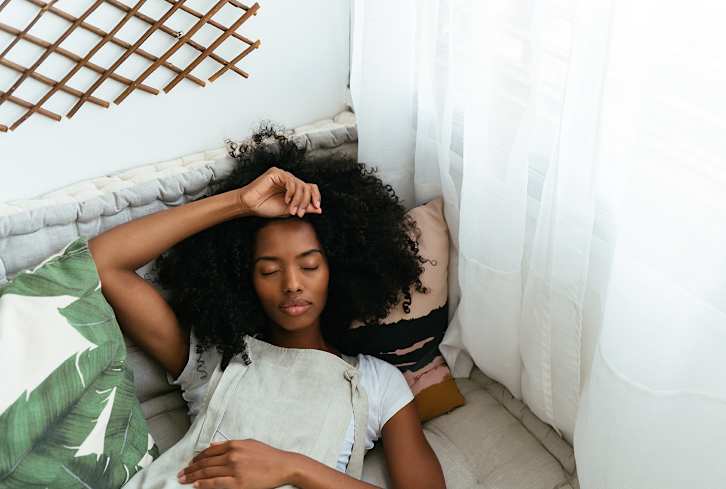Advertisement
Those of you that know me have heard about my first yoga class. For those of you that do not (yet), I'll spare you the nitty gritty and just say this -- it was comical, and torturous. I arrived with basketball shorts down to my knees and old XL Stussy T-shirt. Models pranced painlessly on their mats while crunchies with closed eyes made lamaaz type sounds in the background. And the teacher went on and on and on about getting in touch with your sexual organs while harnessing your inner power and energy like the Hindu gods. Half way through class I faked a cramp in order to escape with some ‘dignity.’ Oh, and I had shot a double espresso before hand to ‘help me sweat.’ Needless to say – disaster. But luckily life, and people, evolve.
I went back to the teacher, and the studio, a week later, and within 3 months I was practicing every day, yes, still in my baller shorts and mega Ts. I was “getting better” – hard not to when you start unable to touch your toes and barely able to hold a plank – but I was not soaring. In fact, it was not until I understood what bandhas were that my practice really evolved, on the inside and on the outside.
Bandha what? Bandha is a word I heard my teachers say in class daily, a word that I wrote off as ‘yogi hippie crap’ until I experientially finally understood what it was all about. And given that took a fair amount of time (over a year of 7 day a week practice), I am going to lay it out for you so you and your practice can take off ASAP.
In Sanskrit bandha means to lock, to hold, or to tighten. It also refers to a lock in and of itself.There are 3 principle bandhas in the body, and a fourth that ties them all together. The ancient yogi philosophers said, and I concur, that when you master the locks, your master the yoga practice, the practice on the outside -- floating in and out of asanas, holding for long periods of time, and managing new positions – and the practice on the inside – consistent single pointed concentration, steady and long breath, and a calm, clear mind. And in a straight-up modern, western sense, the bandhas help you regulate and control all your internal systems, hormonal, sexual, metabolic, digestive, and more. Whether you care about the east, the west, or both, the bandhas are a critical factor to a killer you, and to yoga. Note, bandhas should not be practiced while pregnant.
Mula Bandha: In a way Mula Bandha is the easiest bandha to explain. Just imagine you are in the middle of a 3 hour traffic jam to the airport, the highway has turned into a parking lot, and you have to pee. Or, ladies, you are in white short shorts walking through the park and you get your period a day early. The muscles you instinctually contract to pull up and hold in what is dying to flood out can be generally considered Mula Bandha, or at least the Mula Bandha region.

In Sanskrit mula means root, and thus Mula Bandha is the root lock. To find it, sit, stand, or even be in an asana, and if you are a man, contract the area between the anus and the testes. If you are a woman, contract the muscles at the bottom of the pelvic floor, behind the cervix. Initially the anal sphincter will also contract, but with time and practice you will be able to hone in on the Mula Bandha region and leave the rest aside.
Now don’t freak out! Remember, I thought all this was hogwash too. But the truth is, that Mula Bandha should be held throughout your entire yoga practice. That’s right -- the whole hour or hour and a half. There are countless reasons, but quite simply think of it as the lock that allows your energy to flow up, not down and out. If your energy is forced to flow up, and stay inside you, for that matter, it will grow exponentially, leaving you with that amazing feeling of ‘floating’ as you walk out of out of class. It will also allow you to float IN class, as an engaged Mula Bandha allows you to be lighter on your limbs, and thus lighter on your mat. This lightness prevents you from becoming fatigued when that teacher, aka me, makes you hold something for what seems like forever and a day, or do the umpteenth Chatarunga. In a more physiological sense, Mula Bandha stimulates the pelvic nerves, the genital system, the endocrine system, and the excretory system. It has also been shown to relieve constipation and depression.

Uddiyana Bandha: Moving up from mula bandha we have the second bandha, Uddiyana. In Sanskrit uddiyana means to fly up, or to rise up. This ‘flying up lock’ is thus all about your insides flying upwards, intangibly meaning your energy, tangibly meaning your diaphragm, stomach, and abdominal organs.
To find Uddiyana Bandha start standing up tall, feet about a meter apart. Inhale through your nose and reach your arms up alongside your ears. Exhale out of your mouth and fold forward placing your hands just above your knees. Without inhaling close your lips, straighten your elbows, and feel your abdominal wall and organs push up and back towards your back. It should feel somewhat like a suctioning back and up of everything on the inside. If you are doing it correctly and happen to glance at your profile in a mirror, you should see your waist Marilyn Monroe-style tiny winy, with the ribs noticeably protruding over and in front of your abdomen or belly button. Retain as such for as long as possible, and exit the bandha via inhaling through your nose and standing up straight, raising your arms up along side your ears, then exhaling through your nose again as you move your arms down.
Uddiyana Bandha can be one of the most transformative aspects of your yoga practice, especially as you get more advanced. It moves the energy upwards with much more force than Mula Bandha, thus allowing you to invert and jump more easily, as well as float forward and back more lightly, and twist more deeply. Because the abdominal wall is pressing the organs and tissues of the abdominal cavity backwards, Uddiyana Bandha creates a soft massage for the deeper internal muscles of the lower back.
In a more day-to-day sense, Uddiyana Bandha is the ultimate remedy for abdominal and stomach ailments, from constipation to indigestion. It stimulates your digestive juices, thus increasing your metabolism, and tones your overworked abdominal organs. It also balances the adrenal system, relieving stress, lethargy and tension. And best of all, it is the sure fire way to get flat washboard abs without ever doing any crunches.
Jalandhara Bandha: Jalandhara Bandha is pretty much the only double chin you will want, and try, to have. In Sanskrit jal means throat, jalan means net, and dharan means stream or flow. Thus in the most basic sense, Jalandhara Bandha can be considered the throat lock that controls the flow of energy in the nerves and blood vessels of the neck.
To find Jalandhara Bandha sit up tall, either in a comfortable cross legged position or on your shins with your butt on your heals. Place the palm of your hands on your knees. Inhale slowly and deeply through your nose, then bring your chin towards your neck and lift your sternum ever so slightly. Press down on your hands and straighten your elbows, pull your chin back further, and retain as long as possible. To exit lift your chin, inhale the remainder of capacity into your lungs, and exhale. If you felt a nasty double chin or were stressing about someone taking a picture of your profile, you did it right!
Unlike the first two, Jalandhara Bandha is normally performed in combination with specific breathing practices, and rarely done on its own. That said, it is immensely powerful, as it compresses the sinuses on the main arteries of the neck and in doing so helps regulate the circulatory and respiratory systems. The pressure on the throat helps to balance the thyroid and metabolism. And if no one is looking at you at work, engage Jalandhara Bandha as an instant trigger for mental relaxation as well as stress and anger relief.
Maha Bandha: This the big Kahuna. Maha in Sanskrit means great, and Maha Bandha is the combination of all three aforementioned bandhas.
Sit in a comfortable seat, on your shins or cross legged, palms of the hands on the thighs or knees. Inhale fully through your nose, and exhale completely through your nose. Squeeze squeeze squeeze until every last drop is out. Without inhaling engage Mula Bandha, then find Uddiyana Bandha. Inhale a tiny bit and lift your chest, and from there engage Jalandhara Bandha. Retain, pressing your palms down, as long as possible. When you have had enough, lift your head, inhale fully, and release all the bandhas.
Maha Bandha gives the benefits of all three bandhas and regulates the entire endocrine system. And as an added plus, it makes you a much better swimmer, runner, and of course Little Mermaid impersonator.
That’s that! Super simple. So lock ‘em all up and watch how your yoga practice, and your body, will take off! For at home classes that introduce the bandhas to you in a simple, approachable way, check out I.AM.YOU. on iTunes!
Watch Next
Enjoy some of our favorite clips from classes
Enjoy some of our favorite clips from classes
What Is Meditation?
Mindfulness/Spirituality | Light Watkins
Box Breathing
Mindfulness/Spirituality | Gwen Dittmar
What Breathwork Can Address
Mindfulness/Spirituality | Gwen Dittmar
The 8 Limbs of Yoga - What is Asana?
Yoga | Caley Alyssa
Two Standing Postures to Open Up Tight Hips
Yoga | Caley Alyssa
How Plants Can Optimize Athletic Performance
Nutrition | Rich Roll
What to Eat Before a Workout
Nutrition | Rich Roll
How Ayurveda Helps Us Navigate Modern Life
Nutrition | Sahara Rose
Messages About Love & Relationships
Love & Relationships | Esther Perel
Love Languages
Love & Relationships | Esther Perel
What Is Meditation?
Box Breathing
What Breathwork Can Address
The 8 Limbs of Yoga - What is Asana?
Two Standing Postures to Open Up Tight Hips
How Plants Can Optimize Athletic Performance
What to Eat Before a Workout
How Ayurveda Helps Us Navigate Modern Life
Messages About Love & Relationships
Love Languages
Advertisement

Research Shows Vitamin Deficiency May Up Alzheimer's Risk By 59%
Molly Knudsen, M.S., RDN

Do You Know Your Metabolic Age? Here's How To Find Out (& Improve It)
Mallory Creveling, CPT

Research Shows Vitamin Deficiency May Up Alzheimer's Risk By 59%
Molly Knudsen, M.S., RDN

Do You Know Your Metabolic Age? Here's How To Find Out (& Improve It)
Mallory Creveling, CPT

Research Shows Vitamin Deficiency May Up Alzheimer's Risk By 59%
Molly Knudsen, M.S., RDN

Do You Know Your Metabolic Age? Here's How To Find Out (& Improve It)
Mallory Creveling, CPT

Research Shows Vitamin Deficiency May Up Alzheimer's Risk By 59%
Molly Knudsen, M.S., RDN

Do You Know Your Metabolic Age? Here's How To Find Out (& Improve It)
Mallory Creveling, CPT








